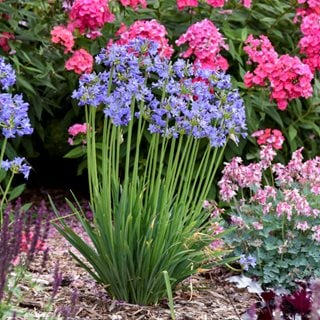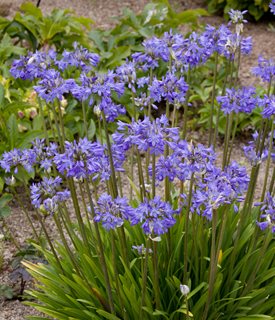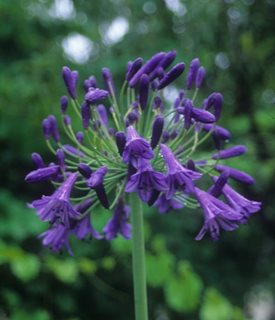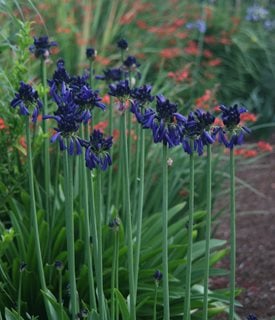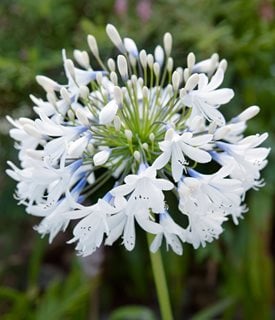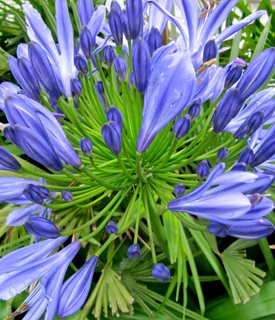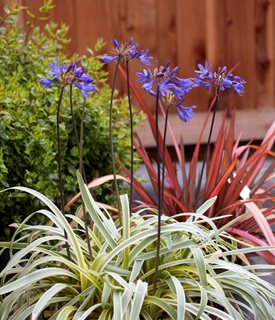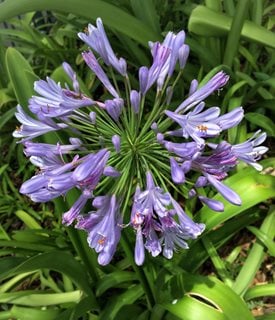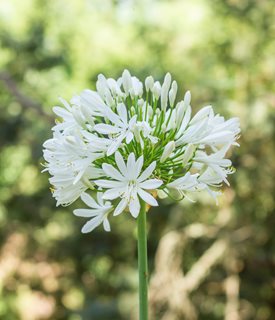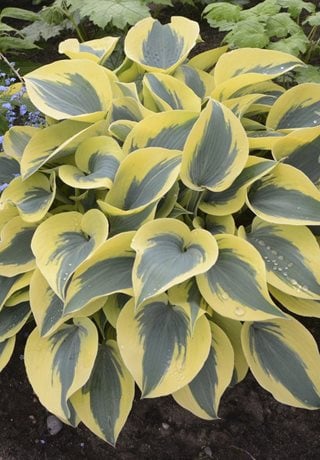Agapanthus: Varieties & Plant Care Info
The best types of agapanthus to grow, plus when to divide them and how to keep them looking great in containersAgapanthus, a popular perennial that grows from a bulb-like rhizome, is a tough survivor in the face of chronic drought. Their strappy evergreen or semi-evergreen leaves provide winter presence while blue or white flowers add a charge of mid to late summer color.
The Agapanthus genus consists of seven species that go by the common name lily of the Nile (or sometimes African lily). Native to dry outcroppings or moist mountain meadows of South Africa, they prefer full sun and draining soils.
On this page: Basics | Planting | Care | Pictures | Design Ideas
On this page:
BASICS
Botanical name:
Agapanthus spp.
Common name:
Lily of the nile, African lily
Zones:
6-11
Exposure:
Full sun
Soil:
Well-drained
Bloom time:
Mid-summer to early autumn
Flower color:
Blue, purple, white
Foliage:
Evergreen, semi-evergreen, or deciduous. The evergreen types are tender in temperatures below 20°F, but the deciduous types are surprisingly hardy.
Height:
The flower stems of a standard Agapanthus can grow up to 6 feet tall, but dwarf types only grow up to 20 inches.
Are agapanthus plants deer resistant?
Most gardeners report that their agapanthus plants are rarely eaten.
Is agapanthus poisonous?
Agapanthus plants aren't true lilies, and don't share their high level of toxicity. However, ingestion of the rhizomes and roots can cause minor illness that can escalate depending on the amount ingested. The sap from the leaves can cause skin irritation.
PLANTING AGAPANTHUS
When to plant:
Plant agapanthus bulbs once soil temps have warmed to 50 degrees F, and all danger of frost has passed.
Where to plant:
Plant in a site that receives full sun (6-8 hours a day). However, in hot climates, they may do better with some afternoon shade.
How to plant:
Place bulbs with the pointed end up, two inches deep, 12 to 18 inches apart, and cover with soil. Protect the root zone with mulch in colder climates.
AGAPANTHUS CARE
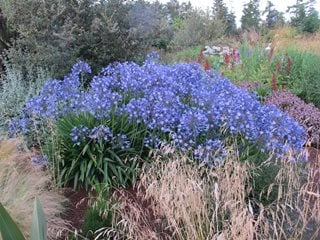
Agapanthus ‘Blue Wave’, shown here, is best in full sun and draining soils. It requires minimal watering. Don’t mulch; do apply an organic fertilizer blend once yearly in late winter. Photo by: Dan Hinkley.
Water:
Provide supplementary moisture during the establishment period. Many also appreciate regular water during the growing season.
Fertilizer:
Apply a well-balanced fertilizer as growth starts in spring. Add a bloom-boosting fertilizer (higher P and K) in August or September when flower buds begin to develop below ground.
Pruning:
Cutting agapanthus back is a matter of personal preference. Some gardeners think the dried flower heads are attractive and provide much needed winter interest. Other gardeners prefer to cut the spent flowers off, a process called deadheading, as soon as they are past their prime. Doing so prevents plants from wasting energy on seed production and instead allows them to store up energy for next year’s bloom.
Division:
Regular division does not seem to be crucial to performance. However, if you wish to divide them for propagation purposes, because they’ve outgrown their bed or pot, or if they aren’t flowering well, here are some guidelines:
- Divide evergreen varieties every 4 to 5 years
- Divide deciduous varieties every 6 to 8 years
- Make the divisions in spring as new growth emerges or in fall after flowering
Overwintering:
Evergreen varieties are more suited to Zones 8-11, but may still need some winter protection from freezing temperatures, which can strike occasionally even in Zone 9. If temps remain below 55 degrees F, insulate the root area with a 2- to 3- inch layer of mulch, or tent the plant with a mini greenhouse.
For Zones 6 or 7, plants can be dug up and overwintered in pots indoors near a sunny window or under grow lights. Transplant back into the garden once temperatures warm up in the spring.
Caring for Potted Agapanthus:
According to renowned plant hunter and gardener Dan Hinkley, “Agapanthus make superb, low-maintenance, and extremely long-lasting container plants.” Here are his tips:
- Provide a protected site during the winter months for potted agapanthus
- They don’t wish to be root-bound so repot frequently
- Protect container-grown plants from excessive wet, but also don’t let them dry out
POPULAR AGAPANTHUS VARIETIES
Other cultivars to try:
- ‘Blue Leap’
- Midknight Blue
- ‘Queen Anne’
- ‘Summer Skies’
- Baby Pete
- ‘Black Pantha’
- ‘Mood Indigo’
- Twister
DESIGN IDEAS
Agapanthus is a versatile plant that can be used in many ways. Here are some suggestions from Hinkley:
- Incorporate Agapanthus into a meadow garden
- Plant them in large drifts of 30-plus plants
- Combine lily of the Nile with the blistering blast of red and orange Crocosmia
- Position them singularly in the mixed border
Warning:
Don’t plant other bulbs too close to Agapanthus—they will be overtaken by the expanding roots.
Portions of this article were adapted from a piece originally written by Dan Hinkley for Garden Design magazine.
RELATED:
21 Blue Flowers for Your Garden
20 Best Summer Bulbs to Grow
Summer Flowering Plants
The Plant Hunter's Retreat
